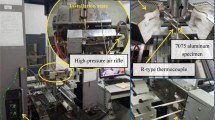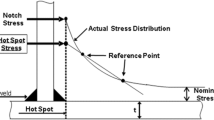Abstract
7000 series high strength aluminum alloys are increasingly used in manufacturing automobile body parts to meet the more stringent demands for automobile lightweight. Hot stamping of 7000 series high strength aluminum alloys is a complex thermal-mechanical coupling process and precise simulation is needed to predict material fracture. To obtain damage model of 7075 aluminum alloy in hot stamping, five different stress triaxiality specimens were designed. The fracture strain, critical strain and average stress triaxiality of different specimens were obtained by the hybrid finite element simulation and experiment (FE-EXP) method. GISSMO model of 7075 aluminum alloy at 400 °C was established. Compared with the experimental results of U-shaped part hot stamping under different lubrication conditions, the calibrated GISSMO model was demonstrated to predict the damage behavior of 7075 aluminum alloy during high temperature deformation accurately.
Similar content being viewed by others
Abbreviations
- D :
-
Damage parameter
- ΔD :
-
Damage parameter increment
- ε f(n) :
-
The failure plastic strain is a function of the triaxiality
- Δε pl :
-
Equivalent plastic strain increment
- n :
-
Damage exponent
- ε f :
-
Failure plastic strain under different stress states
- η :
-
Triaxiality
- F :
-
Instability parameter
- ΔF :
-
Instability parameter increment
- ε crit :
-
Critical plastic strain under different stress triaxialities
- σ*:
-
Stress couple damage and without damage
- D crit :
-
Threshold damage
- m :
-
Fading exponent
- σ :
-
The current flow stress
- ε :
-
The current plastic strain
References
R. Tucker, Trends in automotive lightweighting, Metal Finishing, 111 (2) (2013) 23–25.
J. Lee et al., Mechanical properties and formability of heat-treated 7000-series high-strength aluminum alloy: experiments and finite element modeling, Metals and Materials International, 26 (5) (2019) 682–694.
L. Hou et al., Cryogenic processing high-strength 7050 aluminum alloy and controlling of the microstructures and mechanical properties, Acta Metallurgica Sinica, 53 (9) (2017) 1075–1090.
R. Gu et al., Study on high-temperature mechanical properties and forming limit diagram of 7075 aluminum alloy sheet in hot stamping, Journal of Materials Engineering and Performance, 28 (2) (2019) 7259–7272.
R. Schleich et al., Investigation on the effect of curvature and sheet thickness on forming limit prediction for aluminium sheet metal alloys, International Journal of Material Forming, 2 (2) (2009) 69–74.
S. Bazazzadeh, F. Mossaiby and A. Shojaei, An adaptive thermo-mechanical peridynamic model for fracture analysis in ceramics, Engineering Fracture Mechanics, 223 (2020) 106708.
L. Ying et al., On the thermal forming limit diagram (TFLD) with GTN mesoscopic damage model for AA7075 aluminum alloy: numerical and experimental investigation, Journal of Alloys and Compounds, 802 (2019) 675–693.
R. Wang et al., Failure analysis of AZ31 magnesium alloy sheets based on the extended GTN damage model, International Journal of Minerals Metallurgy and Materials, 20 (12) (2013) 1198–1207.
Z. Wang et al., Effect of upper-die temperature on the formability of AZ31B magnesium alloy sheet in stamping, Journal of Materials Processing Technology, 257 (2018) 180–190.
G. Chen et al., Modeling of material orientation effects on AHSS, Traffic Injury Prevention, 14 (2013) S23–S29.
Y. Lou and H. Huh, Prediction of ductile fracture for advanced high strength steel with a new criterion: experiments and simulation, Journal of Materials Processing Technology, 213 (2013) 1284–1302.
Y. Lou and H. Huh, Extension of a shear controlled ductile fracture model considering the stress triaxiality and the Lode parameter, International Journal of Solids and Structures, 50 (2013) 447–455.
F. Neukamm, H. André and M. Feucht, Consistent damage modelling in the process chain of forming to crashworthiness simulations, Proc. of 12th European LS-DYNA Conference, Koblenz (2008) 11–20.
Z. Q. Zhang, Y. J. Cui and G. Yu, Damaged and failure characterization of 7075-T6 Al alloy based on GISSMO model, Journal of Mechanical Science and Technology, 35 (12) (2021) 1209–1214.
G. Venturato, A. Ghiotti and S. Bruschi, Stress-state dependent formability modelling in hot stamping, Production Engineering, 14 (2020) 105–114.
G. D’Amours and A. Ilinich, Plasticity and damage modeling of the AA7075 aluminium alloy for hot stamping, Proc. of 15th International LS-DYNA Users Conference, Detroit (2018).
L. P. Caro et al., Damage and fracture during sheet-metal forming of alloy 718, International Journal of Material Forming, 13 (1) (2020) 15–28.
M. Kim and S. Hong, Prediction of shear fracture in multistage deep drawing process including ironing process for Al3003 sheet, International Journal of Advanced Manufacturing Technology, 101 (1) (2019) 747–755.
H. Gao et al., Experimental and simulation investigation on thermal-vibratory stress relief process for 7075 aluminium alloy, Materials and Design, 195 (2020) 1–14.
G. L. Rosa, G. Mirone and A. Risitano, Effect of stress triaxiality corrected plastic flow on ductile damage evolution in the framework of continuum damage mechanics, Engineering Fracture Mechanics, 68 (4) (2001) 417–434.
J. L. Chaboche, Continuum damage mechanics, part I: general concepts, Journal of Applied Mechanics, 55 (1) (1988) 59–64.
N. Bonora et al., CDM modeling of ductile failure in ferritic steels: assessment of the geometry transferability of model parameters, International Journal of Plasticity, 22 (11) (2006) 2015–2047.
L. P. Caro et al., Damage and fracture during sheet-metal forming of alloy 718, International Journal of Material Forming, 13 (1) (2020) 15–28.
J. Lemaitre, How to use damage mechanics, Nuclear Engineering and Design, 80 (1) (1984) 233–245.
S. Dziallach et al., Sheet metal testing and flow curve determination under multiaxial conditions, Advanced Engineering Material, 9 (11) (2007) 987–994.
Y. Lou and H. Huh, Prediction of ductile fracture for advanced high strength steel with a new criterion: experiments and simulation, Journal of Materials Processing Technology, 213 (8) (2013) 1284–1302.
T. Goel and N. Stander, Multi-Objective Optimization Using LS-OPT, Livermore Software Technology Corporation, Livermore, CA (2007).
D. Steffeslai and T. Clees, Efficient stochastic analysis of process chains, Proc. of 1st Multiphysics Conference, Bonn (2010).
F. X. C. Andrade et al., An incremental stress state dependent damage model for ductile failure prediction, International Journal of Fracture, 200 (2016) 127–150.
F. Andrade, M. Feucht and A. Haufe, On the prediction of material failure in LS-DYNA: a comparison between GISSMO and DIEM, Proc. of 13th International LS-DYNA Users Conference, Detroit (2014).
L. Wei, F. Qin and K. Cui, Prediction the stainless steel sheet fracture with mesh size effect for shell elements, International Journal of Solids and Structures, 210–211 (21) (2021) 35–48.
Acknowledgments
This work was supported by “13th five-year” Scientific Research Planning Project of the Education Department of Jilin Province, China (JJKH20180128KJ).
Author information
Authors and Affiliations
Corresponding author
Additional information
Qingmin Chen is a Senior Engineer of Roll Forging Research Institute, Jilin University, Changchun, China. His research interests include roll forming, roll forging forming and automation of forging equipment.
Rights and permissions
About this article
Cite this article
Zhang, Z., Cui, Y. & Chen, Q. Damage and failure characterization of 7075 aluminum alloy hot stamping. J Mech Sci Technol 36, 351–357 (2022). https://doi.org/10.1007/s12206-021-1234-4
Received:
Revised:
Accepted:
Published:
Issue Date:
DOI: https://doi.org/10.1007/s12206-021-1234-4




